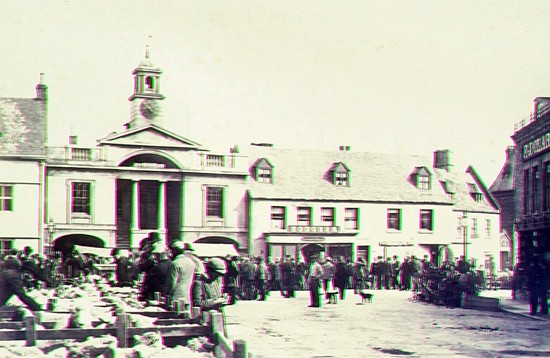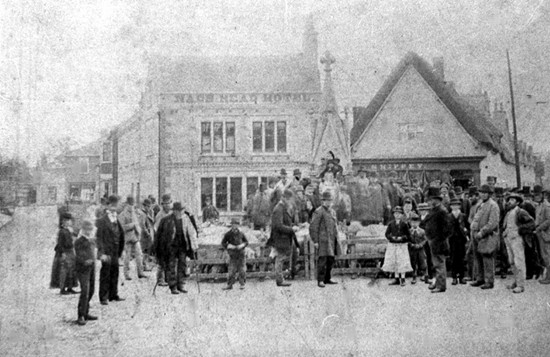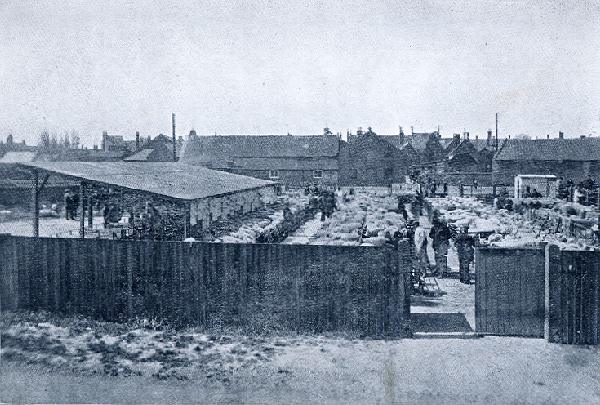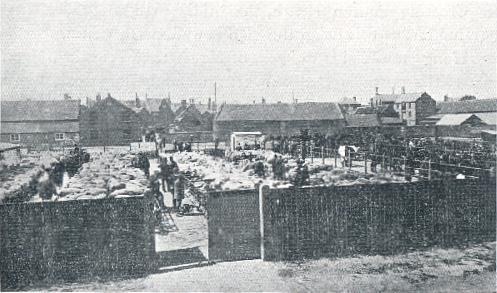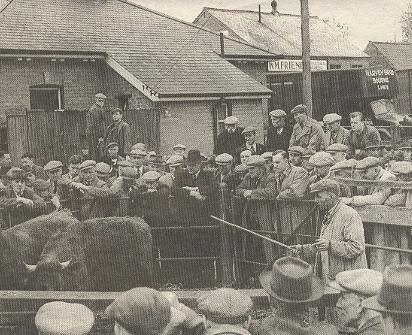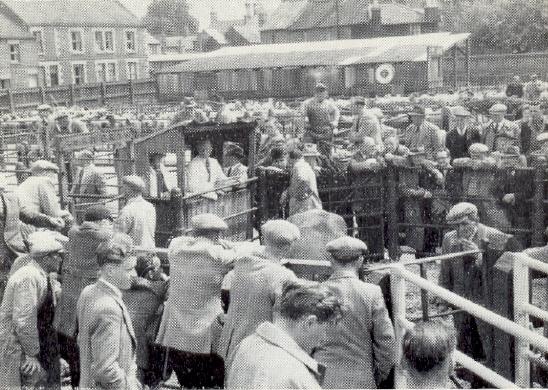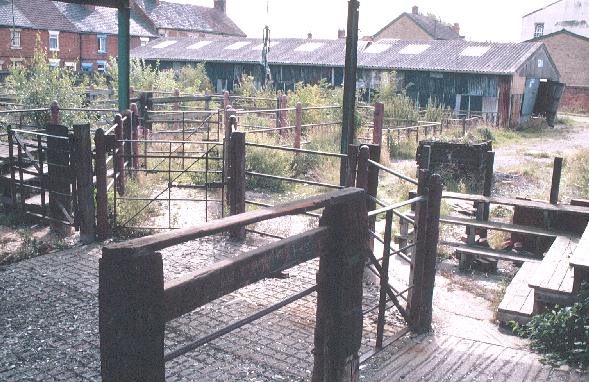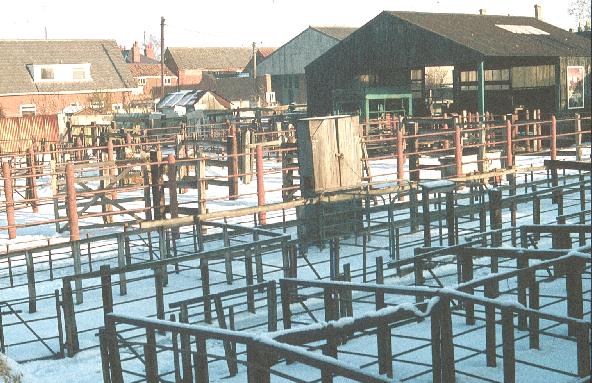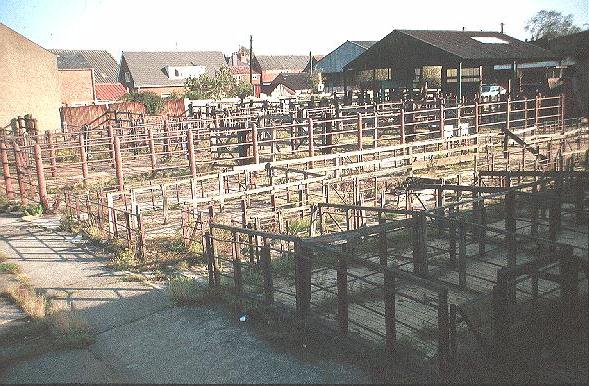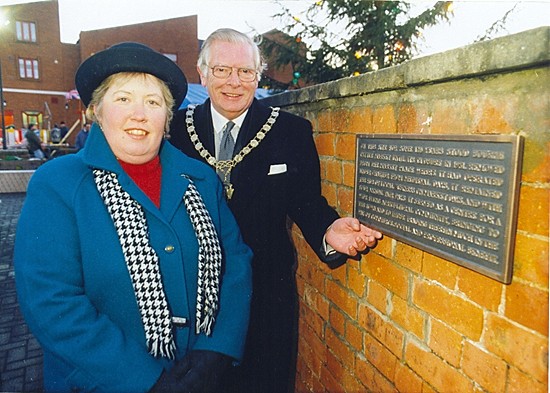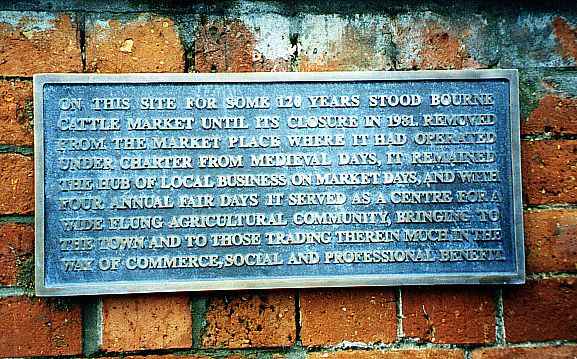|
The cattle market
The sale and purchase of livestock at a purpose built cattle market was a feature of the commercial life in Bourne for more than a century but it was forced to close in 1981 because of increasingly restrictive regulations that were introduced through EEC legislation. The site slowly became derelict with disuse and was eventually replaced by the Burghley Arcade development that was opened between 1988-90. This included a new off-street site for the weekly market which had until then been held along the kerbside in the town centre and in 1998, the part that the cattle market had played in the history of Bourne was remembered when a commemorative plaque was placed on a side wall saying: "On this site for some 120 years stood Bourne cattle market until its closure in 1981. Removed from the market place where it had operated under charter from mediaeval days, it remained the hub of local business on market days and where four annual fair days it served as a centre for a wide flung agricultural community, bringing to this town and to those trading therein much in the way of commerce, social and professional benefit." Bourne was a centre for livestock sales for centuries and on Saturday 21st August 1824 a meeting was held at the Town Hall to regularise the events under the chairmanship of Mr Henry Ryde, agent to the Marquess of Exeter who held the market rights. A committee was appointed and it was decided that in consequence of the large number of cattle bred in the neighbourhood, and the large quantity of corn and other agricultural crops produced from the surrounding farmland, regular fairs and markets for their sale and purchase would be held. Until then, there had been three fairs each year but the events had not been regular and the meeting agreed on specific dates for the future and that they would all be organised on a more official footing. The dates agreed were April 7th, May 6th and 29th October, except when they fell on a Sunday in which case the market would be held on the Saturday preceding. The resolutions agreed by the meeting were as follows, as printed by the Stamford Mercury on Friday 27th August 1924:
1: That in consequence of the great number
of cattle bred and fed in the neighbourhood, and from the great quantity of corn
and other agricultural produce supplied from a large tract of fertile land
surrounding the market town of Bourne, and from the extensive improvements and
accommodations recently made, and now making there, it is the opinion of this
meeting, that the town of Bourne affords a most convenient situation whereat to
hold fairs for the sale and purchase of cattle of all descriptions, and of all
other articles of agricultural produce. The arrangement began with a market on Friday 29th October which was an immediate success and soon the town was attracting buyers and sellers from many miles around when pens and stalls were set up in the market place [now the town centre]. The business was given an added impetus with the opening of the Bourne and Essendine railway in 1860 providing a facility for bringing in livestock from a much wider area, and so a newly established stock market opened on Thursday 4th October 1860. Until then, it had been held on Saturdays but Thursday was chosen for future markets because the day did not clash with any other being held in the neighbourhood. This was decided at a public meeting held at the Angel Hotel on 27th April 1860 when the majority opinion was that the market place would be the most appropriate site for holding it although central government was already advising local authorities that new fair grounds should be selected in the suburbs of towns wherever possible "to avoid the various inconveniences and annoyance attending the holding of stock fairs in public thoroughfares, particularly in those within the precincts of a town". The popularity of the new venue however, was never in doubt and the Stamford Mercury reported on Friday 12 April 1861: The spring fair on Monday last was one of the best held in Bourne for some years, being well attended by dealers and agriculturists. There was more than an average show of sheep and beasts but had the quality been larger there is reason to believe that they would have been generally disposed of, the demand being greater than the supply. There were several good pens of hogs, one lot of 100 making 47s., and we heard of one lot which changed hands at a profit three times. The alteration of holding the fairs in the Market Place and adjoining streets seems to obtain general favour, some persons thinking that to hold the fairs entirely at the back of the town is like "putting your light under a bushel". Now that we have the facilities of railway transit and other advantages, the Market and Fairs Committee hope that the agriculturists of the neighbourhood will do all in their power to increase the importance of the town by its position in the midst of a rich agricultural district, being suitable for and properly entitled to good fairs and markets. The market place remained an extremely popular venue and on Friday 19th September 1873, the newspaper reported: From the favoured position of this town, it being in the centre of the finest agricultural and grazing districts of Lincolnshire, the weekly stock market held here has very materially increased. On the 11th inst, there were from 400 to 500 sheep penned and all sold at very good prices by Messrs Lawrence and Carter and Mr Robert Chapman. A very fine pen of twelve sheep belonging to Mr Freeman, of Dyke, realised from £5 to five guineas each. We are requested to remind purchasers and others interested that it is very desirable to commence the stock sales punctually at 11 o'clock so that they may not interfere with the time for commencing the corn market. But it was to be another 18 years before the cattle market was finally moved off the streets to a site off Hereward Street behind the Marquess of Granby. In 1898, it was run by William Edward Wadsley, an auctioneer of West Street, and he was responsible for a new layout of the site which reopened on Tuesday 5th July when 250 sheep and 30 beasts passed through. The Stamford Mercury reported: "There was a very good show of sheep and beasts and good prices were realised all round."
The redesigned site was a lasting success and in 1909, J J Davies wrote in his book Historic Bourne: "The new market, in every way admirably adapted to its purpose, is the result of well-directed energy and enterprise. Pens, premises and equipment fully abreast of the most recent improvements, and the popularity of the market is attested by the large attendance of buyers and dealers from all parts at the weekly sale on Thursdays." The state of the cattle market began to decline during the middle years of the 20th century when it became evident that the location was not ideal for an expanding town and in September 1962 a report was made to a meeting of Bourne Urban District Council by the public health inspector, Mr L W Brown, in which he said: "The generally poor state of the market and its operation were referred to the Ministry of Agriculture. Some improvements in the paving and drainage were affected. The matter of noise from beasts left in the pens overnight is not one for the council but it is a pity that the cattle market has to remain in this particular area with its residential blocks in proximity and served only by narrow congested streets." Further signs of its uncertain future became apparent in 1979 when Harry Lyall, of Lyall and Company, auctioneers, of Bourne, warned that it would close unless farmers supported it throughout the year and not just at the time of the Christmas Fatstock Show. He told the Stamford Mercury on Friday 9th February: There is obviously a large number of farmers who enjoy bringing out their show animals and competing against old and respected rivals in the atmosphere of a friendly market and who like to see them sold at auction. But in order to hold a Christmas show, it is essential that the market thrives all year round. Markets whose through-put is not up to a required average number of animals a week can have their grading and certification facilities withdrawn by the Meat and Livestock Commission, as has already happened at five markets elsewhere in East Anglia. Farmers appear to have a preference for auctions as opposed to deadweight marketing and they still produce animals for the butcher but we do not get the regular consignments of stock that were once sent. People are constantly complaining about the cost of transport and from this aspect alone I would have thought that a thriving market in Bourne would be to their advantage. I therefore appeal for your support, not only at Christmas but on every Thursday throughout the year when you have prime stock ready for the butcher. It will not be an easy trade to build up again but I am confident that if numbers are increased every week we can find the buyers. This cannot happen overnight and the danger is that we may increase for a week or two and then fall back to the previous numbers and so it is essential that levels are maintained for a long enough period to convince buyers that they can rely on us. It will be to our mutual benefit if we can restore Bourne market to its old prominence. But Mr Lyall's prediction proved to be premature. The market remained at this location until it was closed in 1981 and the site was eventually developed for the present weekly open air market place.
See also
Market poster of 1824 More photographs from past times
The Christmas Fatstock Show The market place
Go to: Main Index Villages Index
|
|||||||||||||||||||||||||||
